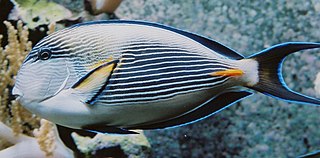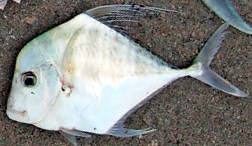
Acanthuridae are the family of surgeonfishes, tangs, and unicornfishes. The family includes about 86 extant species of marine fish living in tropical seas, usually around coral reefs. Many of the species are brightly colored and popular in aquaria.

Acantopsis is a genus of freshwater fishes, commonly known as horseface loaches or banana-root fishes, in the family Cobitidae. Fishes of the genus Acantopsis inhabit sandy riverbeds throughout Southeast Asia. The common horseface loach, A. rungthipae, is popular in the aquarium trade.

The black swallower, Chiasmodon niger, is a species of deep sea fish in the family Chiasmodontidae. It is known for its ability to swallow fish larger than itself.

The viviparous brotulas form a family, the Bythitidae, of ophidiiform fishes. They are known as viviparous brotulas as they generally bear live young, although there are indications that some species do not. They are generally infrequently seen, somewhat tadpole-like in overall shape and mostly about 5–10 cm (2–4 in) in length, but some species grow far larger and may surpass 60 cm (2 ft).

Mikrogeophagus is a genus of small cichlids native to the Amazon and Orinoco basins in South America. Both species are popular with aquarists, especially M. ramirezi.

Foetorepus is a genus of dragonets. The validity of this genus has been questioned with some experts regarding it as a junior synonym of Synchiropus.

The scalloped bonnethead is a rare, little-known species of hammerhead shark, and part of the family Sphyrnidae. Its other common names include the mallethead shark and the crown shark. It is found in tropical and subtropical waters in the eastern Pacific Ocean, from Mexico to Peru, and possibly as far north as the Gulf of California. It frequents inshore habitats over soft bottoms to a depth of 100 m, and also enters mangroves and estuaries.
Mastacembelus is a genus of many species of spiny eel fish from the family Mastacembelidae. They are native to Africa and Asia. Most are found in rivers and associated systems, but there are also species in other freshwater habitats and a particularly rich radiation is found in the Lake Tanganyika basin with 15 species. A few species can even occur in brackish water.
Tristramella intermedia is an extinct species of fish in the family Cichlidae. It was endemic to Lake Hula in northern Israel. This taxon was considered to be a subspecies of T. simonis in FishBase and considered a synonym of T. simonis by Catalog of Fishes, a view with which FishBase now concurs. This species reached a length of 22.9 centimetres (9.0 in) TL.
Tristramella magdelainae is an extinct species of cichlid fish. It was endemic to the vicinity of Damascus in Syria. It was last recorded in the 1950s, has not been recorded since and is presumed extinct. Drought, pollution and water extraction may have destroyed its habitat. This taxon is considered to be a subspecies of T. simonis in FishBase and considered a synonym of T. simonis by Catalog of Fishes, a view that FishBase now (2018) concurs with. This species reached a standard length of 13 cm (5.1 in).

The Indian threadfish, also known as the Indian threadfin, diamond trevally, mirror fish or plumed trevally, is a large species of coastal marine fish of the jack family, Carangidae. The species is widespread in the waters of the tropical Indo-West Pacific Ocean, ranging from east Africa to India, Asia, Indonesia and Australia. Adult fish tend to inhabit coastal waters over reefs down to 100 m in depth, while juveniles inhabit a variety of environments including estuaries and seagrass beds. The Indian threadfish is similar to the other two species in the genus Alectis, with a slight concavity in the profile of the head the most obvious distinguishing feature. It is a large species, growing to 165 cm and 25 kg in weight. The species is carnivorous, consuming fishes, cephalopods and crustaceans. The Indian threadfish is of minor commercial importance, and has been the subject of aquaculture in Singapore.

Dysalotus is a genus of fish in the family Chiasmodontidae found in the Atlantic, Indian and Pacific Ocean.

Kali is a genus of snaketooth fishes, deep ocean fish from the family Chiasmodontidae.

Pseudoscopelus is a genus of snaketooth fishes.
The Cichlid Room Companion (CRC), is a membership-based webpage dedicated to the fishes of the Cichlid family (Cichlidae). The site offers arguably the most comprehensive authoritative catalogue of cichlids in the web, which is illustrated with more than 20,000 photographs of fishes and 1,000 of habitats, as well as over 270 videos of cichlids and their habitats. It also “offers access to information about over 150 full genera and 900 full species profiles”, a discussion forum, as well as various articles about taxonomy, natural history, fish-keeping, field accounts, collecting expeditions and other cichlid related topics; mostly written by citizen scientists and people who specialize in cichlids. The species summaries provided in the form of profiles include taxonomic, distribution and habitat, conservation, natural history, captive maintenance and an extensive bibliography of the species included and have been prepared by world class specialists. A document establishes the standards followed in the preparation and maintenance of the cichlid catalogue. The site is administered by its creator and editor, Juan Miguel Artigas-Azas, a naturalist, whom is also an aquarist and a notorious nature photographer. In 2008, the American Cichlid Association (ACA) awarded Artigas-Azas the Guy Jordan Retrospective Award, which is the maximum honor that association gives to people who have done extensive contributions to the International Cichlid Hobby.
Labeo djourae is a species of freshwater fish belonging to the genus Labeo. It is endemic to the Benue River in Chad. It is sometimes considered conspecific with Labeo parvus.
Labeo latebra is a species of freshwater fish belonging to the genus Labeo. It is endemic to the upper Nile basin in Sudan.
Labeo nigrescens is a species of freshwater fish belonging to the genus Labeo. It is endemic to Karnataka in India. It is sometimes considered conspecific with Labeo calbasu.
Labeo vulgaris is a species of freshwater fish belonging to the genus Labeo. It is endemic to Egypt. It is sometimes considered conspecific with Labeo niloticus.

Sebastes cheni, the Japanese white seaperch or Japanese blueback seaperch, is a species of fish in the rockfish family found in the Northwest Pacific. The species is a popular quarry for anglers. White seaperch is fished for food and game fishing.












